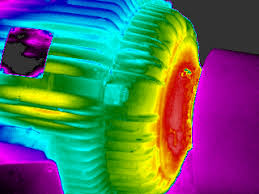Motor_Temperature_Calc.xls

Description
Excel spreadsheet to determine the temperature affect on DC & Brushless DC motors. Based on whitepaper by Edward Hage.
http://www.specamotor.com/pdf/overheating_white_paper.pdf
Calculation Reference
DC Motor
A general summary of how temperature affects DC and brushless DC (BLDC) motors. Temperature plays a significant role in the performance, efficiency, and longevity of both DC and brushless DC motors. As the temperature of the motor increases, various factors come into play, which can affect motor operation:
-
Winding resistance: As temperature increases, the resistance of the copper windings in the motor also increases. Higher resistance leads to a higher voltage drop across the windings, reducing the voltage available to generate torque and causing a reduction in motor efficiency.
-
Magnetic properties: The permanent magnets used in both DC and BLDC motors can be sensitive to temperature. As temperature increases, the magnetic properties of the magnets can degrade, causing a decrease in motor performance. In extreme cases, the magnets can reach their maximum operating temperature and suffer irreversible demagnetization, leading to a significant reduction in motor torque and efficiency.
-
Lubrication: The lubrication used in motor bearings is temperature-sensitive. As the temperature increases, the lubricant's viscosity can decrease, reducing its effectiveness in reducing friction and wear. This can result in increased bearing friction, decreased motor efficiency, and potentially premature bearing failure.
-
Thermal expansion: As the motor temperature increases, the various components of the motor can expand due to thermal expansion. This can cause increased friction and wear in the motor, leading to reduced efficiency and possibly motor failure.
-
Motor insulation: The insulation materials used in the motor windings can degrade under high temperatures, which can lead to short circuits, reduced motor life, and potential motor failure.
To minimize the impact of temperature on motor performance, it is essential to manage the motor's thermal conditions through appropriate cooling methods, such as forced air cooling, heat sinks, or liquid cooling systems. Moreover, choosing motors with adequate temperature ratings and using temperature sensors to monitor motor temperature can help ensure safe and efficient operation.
Calculation Preview
Full download access to any calculation is available to users with a paid or awarded subscription (XLC Pro).
Subscriptions are free to contributors to the site, alternatively they can be purchased.
Click here for information on subscriptions.
